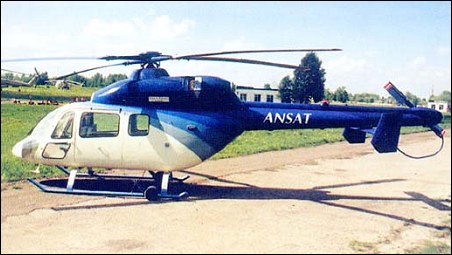
| Kazan Helicopter Plant "Ansat" 1999 |  |
 |

| Kazan Helicopter Plant "Ansat" 1999 |  |
 |
|
English name: Light TYPE: Light utility helicopter. PROGRAMME: Design begun at Kazan in 1993; design subcontracts to Kazan State Technical University for structural strength and aerodynamic calculations; Aviacon Scientific and Production Centre for rotor; and Aeromekhanica for transmission. Name in Tatar language variously translated as easy, simple, ethereal and light. Fuselage mockup exhibited at 1995 Paris Air Show; considerably revised engineering mockup (001) at Paris '97; by August 1998, now marked '01', this had accumulated 10 hours of ground running with engines and rotors; total 800 hours by February 2003. First flight scheduled for late 1997, but initial designated flight trials aircraft (02) exhibited at Farnborough in September 1998, still unflown. First flight (02) was 12 minute hover on 17 August 1999; initial forward flight on 6 October 1999. Trials halted in November 1999, after 4 hours, due to gearbox problems; resumed in second quarter of 2000 with strengthened and redesigned main transmission, scarfed engine exhausts and new identity '902'. Total 120 hours up to February 2003. Third (second flying) prototype (03) was to have joined the programme in late 1999, but not completed until August 2001. First flown 27 December 2001, this is to preproduction standard with small, detachable, pannier tanks, increased fin area, PW207 engines, additional side window and flatter windscreen combined with revised nose shape; will add 400 hours to trials programme. Certification flight resting began in October 2002, for completion before end of 2003; by early 2003 had been renumbered '904'. On 14 September 2001, Ansat declared winner of competition to supply 100 training helicopters to Russian armed forces by 2015 (beating Mi-34 and Ka-226). CURRENT VERSIONS: Can be optimised for transport (including underslung load), ambulance, SAR, training, patrol and other duties. Provision for attachment of sponsons or tanks to sides of cabin. Ansat: As described. Ansat-U: Optimised for training (uchebni). Aircraft No.5 to this standard, including dual controls and wheel landing gear. Expected to have TV-500A turboshafis. Ansat-AG: Version for Gazprom pipeline inspection. Ansat Nablyudatel: (Ansat Observation) Mockup of proposed scout helicopter based on Ansat was shown at Moscow Salon in August 2001. GOES 521 turret in nose with Svishch sensors integrated by Optooil ZAO. CUSTOMERS: Armed forces of Russia to purchase 100 by 2015. Russian Federal Border Service (Federalnaya Pogranichnaya Sluzhba) requirement for 100 notified in 1997. Under consideraiion by Gazprom in 2000 for pipeline inspection (100 required). Total 12 civil sales reported by late 2002, including one for export. COSTS: US$2.0 million for utility version (2003). Kazan's development expenditure had reached Rb200 million by mid-2000. DESIGN FEATURES: Optimised for aerodynamic efficiency, survivability in emergency landing (1m/s power-off touchdown speed) and off-base routine maintenance. Traditional metal structure for simplicity and reliability. Meets FAR Pt 29 Category A and Russian AP-29 requirements. First Russian helicopter with shock-absorbing seats for passengers. Conventional configuration, with high-mounted tailboom carrying fixed horizontal stabiliser and twin fins; power plant above cabin. Hingeless main rotor hub with glass fibre torsion bar; four main blades; two-blade tail rotor. Two-stage, VR-23 main rotor reduction gear in magnesium case ahead of engines; ratio 16.4; rotation speed 365.4 rpm; blade tip speed 220m/s. Transmission rating 769kW. Tail rotor speed 2,000 rpm via single stage conical geabox. Rotor brake. Manual blade folding. Main rotor aerofoil section NACA 23012. STRUCTURE: Aluminium alloy fuselage; sparing use of composites; layered glass fibre main rotor blades, window frames and nosecone. LANDING GEAR: Twin skids with Kazan transverse shock-absorbers; tail bumper to protect anti-torque rotor. Wheels optional; tricycle configuration, with Yaroslav tyres and Gidroagregat (Balashikha) brakes. Optional emergency notation system. POWER PLANT: Two P&W Rus XRK206S turboshafts, each rated at 477kW for T-O, 418kW max continuous, in prototypes. Production version with PW207Ks, rated at 470kW for T-O, 410kW max continuous, 529kW for 30 s, 470kW continuous OEI and 491kW 2 minutes OEI. FADEC standard. Fuel capacity 700 litres in either external panniers or underfloor. Optional internal ferry fuel. Alternatively, two Salyut TV-500A turboshafts, each 478kW. ACCOMMODATION: Up to 11 persons, including one or two pilots, on energy-absorbing seats; or two stretcher patients and three attendants; or internal or externally slung freight. Two forward-hinged doors each side of flight deck; two horizontally split doors each side of cabin, forward; baggage bay behind cabin, with rear-facing door. Baggage door also used for loading stretchers of medical variant. Accommodation ventilated and heated; optional air conditioning. SYSTEMS: Avionika FBW controls comprise quadruples electronic system and duplex hydraulic system. Automatic flight control is standard on all piloting functions and optional on navigation functions. Current FBW system to be replaced by KSU-A digital control system. Main transmission drives two alternators (each 200V, 400Hz), two generators (each 27V), two fans and two hydraulic fuel pumps for separate systems. Electrical system 27V, with battery; optional AC system, with second battery. Electric de-icing optional. AVIONICS: Standard Russian avionics and instruments (apart from prototypes' BAE Systems North America engine parameters display, which to be replaced by Ulyanovsk BISK-A system); full Western avionics fit available as an option. EQUIPMENT; Cabin tie-down points. Optional rescue hoist and sling. ARMAMENT: Optional external rocket and machine gun pods. Jane's All the World's Aircraft, 2004-2005
|